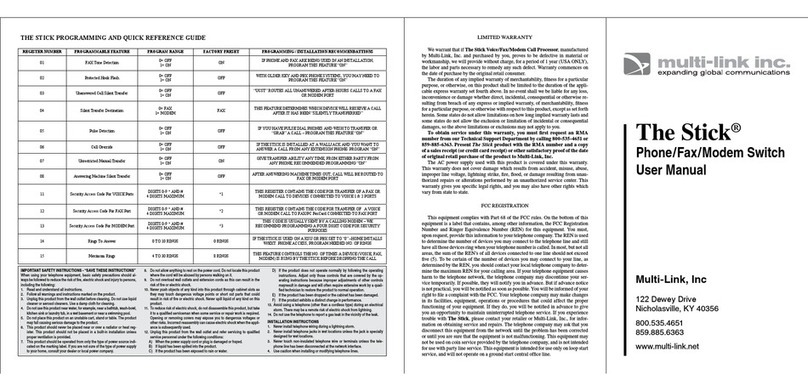
3
© Multilink Inc. 2020 •All Rights Reserved © Multilink Inc. 2020 •All Rights Reserved
Multilink Inc. 580 Ternes Ln. | Elyria,OH 44035 | 440.366.6966 | www.gomultilink.com
EMI / RFI STATEMENT
This device has been designed and manufactured to comply with the EMI / RFI emission limits and
immunity characteristics as set forth in Standards EN 55022 and EN 55024. These limits are designed
to provide reasonable protection against harmful interference when this equipment is operated in a
commercial environment. This equipment generates, uses, and can radiate radio frequency energy and,
if not installed in accordance with this instruction manual, may cause harmful interference to radio
communications.
Critical Safety Issues
Section 1: Critical Safety Issues
SAFETY ADMONISHMENTS
Three dierent levels of safety admonishments are used within this instruction manual; specically
DANGER, WARNING, and CAUTION.
Trois niveaux diérents d’avertissements de sécurité sont utilisés dans ce mode d’emploi; spéciquement DAN-
GER, AVERTISSEMENT et ATTENTION.
DANGER
The statement following the DANGER heading alerts the equipment user of a potentially life or
health-threatening situation unless precautions are taken against it. Admonishments of this nature
usually entail the hazards of electrical shock or those encountered that may result in physical injury.
La déclaration sous la rubrique DANGER avertit l’utilisateur de l’équipement d’une situation potentiellement
mortelle ou mortelle, sauf si des précautions sont prises contre lui. Les admonistances de cette nature entraî-nent
habituellement les dangers d’un choc électrique ou ceux rencontrés qui peuvent entraîner des blessures phy-
siques.
WARNING / AVERTISSEMENT
The statement following the WARNING heading alerts the equipment user of a condition or procedure that
could result in interruption of service to the users or subscribers of the service receiving power from this
product.
La déclaration sous le chapitre AVERTISSEMENT avertit l’utilisateur de l’équipement d’une condition ou d’une
procédure qui pourrait entraîner une interruption de service pour les utilisateurs ou les abonnés du service qui
reçoit l’alimentation de ce produit.
s
Section 1: Critical Safety Issues 3
Safety Admonishments................................................................................................................................................................................................... 3
Emergency Shutdown..................................................................................................................................................................................................... 4
General Safety Issues........................................................................................................................................................................................................ 4
Safety Issues with the SATS Installation & Use....................................................................................................................................................... 4
Multiple Power Sources................................................................................................................................................................................................... 5
Enclosure Safety Issues.................................................................................................................................................................................................... 5
Section 2: Introduction 6
Safety Automatic Transfer Switch Overview of Operation................................................................................................................................. 6
Features................................................................................................................................................................................................................................. 6
Unpacking & Inspection.................................................................................................................................................................................................. 6
Missing or Damaged Items............................................................................................................................................................................................ 7
Original Shipping Container.......................................................................................................................................................................................... 7
Section 3: Front Panel Controls & Connections 8
Controls................................................................................................................................................................................................................................. 8
Connections ........................................................................................................................................................................................................................ 8
Section 4: Installation and Setup 9
Preparation .......................................................................................................................................................................................................................... 9
Grounding............................................................................................................................................................................................................................ 9
Placement in the Enclosure.........................................................................................................................................................................................10
Wiring ..................................................................................................................................................................................................................................11
Section 5: Startup & Operation 13
Operating Modes.............................................................................................................................................................................................................13
Section 6: Shutdown 15
Section 7: Replacement Parts 15
Part List...............................................................................................................................................................................................................................15
Section 8: Troubleshooting 16
Section 9: Specications 17
Parameter Specications & Notes .............................................................................................................................................................................17




























